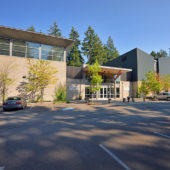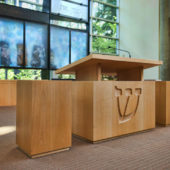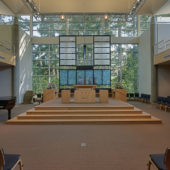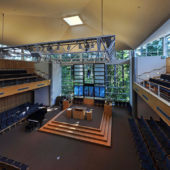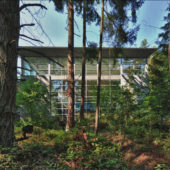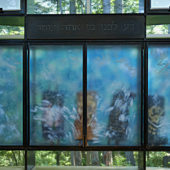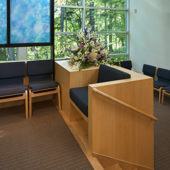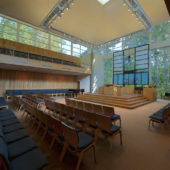The largest Reform congregation in the Pacific Northwest was formed in a 1971 merger of Temple De Hirsch of Seattle and Temple Sinai of Bellevue, Washington.
The largest Reform Jewish congregation in the Pacific Northwest is the result of the merger of Seattle’s Temple de Hirsch with Bellevue, Washington’s Temple Sinai. While the photographs on this website show the newer building in Bellevue, the 1500 family congregation is served from both of both campuses.
German speaking Jews arrived with the first waves of settlers to the Pacific Northwest area of the United States in the early to mid 19th century. There is documentation of Jews opening grocery and hardware stores in Seattle in 1862, and in 1875 the city elected a Jew as its sixth mayor. In the 1880s Jews from all over Eastern Europe formed the second wave of immigrants and by the first half of the 20th century, strong Ashkenazic Orthodox and Reform communities had taken root in Seattle. Beginning in 1902, the third wave of Jews from Turkey, Greece and Rhodes settled in the Pacific Northwest. Since World War I, Seattle has had the largest percentage of Sephardic Jews compared to the total Jewish population of any city in the United States.
On May 29, 1899, seven men met in Morris Hall to form a Jewish congregation based on the principles of Reformed Judaism. The newly formed congregation was named after the English Jewish philanthropist, Baron Maurice de Hirsch. Seventy families contributed $2400 and two years later, the cornerstone was laid for the new temple. The basement was built and services were held in the vestry; however, the building was never completed. Due to the rapid growth of the congregation a larger site was purchased and a new synagogue constructed. The first services were held in the vestry on November 22, 1908.
In 1906 Koch took over as Senior Rabbi and under his leadership, the membership grew even more. The congregation’s newsletter, ‘Temple Tidings’ began publication in November 1909. Koch admonished, educated and preached to the congregation through the publication and his sermons were re-printed. In 1910 Temple De Hirsch acquired the Hills of Eternity Cemetery. A strong religious education program for the children from kindergarten through Confirmation was begun. Koch was outspoken for a variety of social causes and served on the boards of many Seattle social service agencies. He worked to create the Children’s Hospital and to foster ties between Christians and Jews. In 1924, the Temple Center was built to house the religion school, library, and various social programs, under Koch’s tenure. Koch was succeeded by Rabbi Levine, from Lithuania. Levine inspired the award winning TV show “Challenge,” which featured local Protestant, Catholic and Jewish clergy discussing issues of the day from their various viewpoints. He initiated Jewish camping programs for the youth, stressing friendship, worship and study. Samuel Goldfarb was the musical director for over three decades, organizing choirs and musical performances for all ages. In 1960 a new premises was built to accommodate the growth in membership.
In 1971 Temple De Hirsch merged with Temple Sinai, a Reform Synagogue in Bellevue, forming Temple De Hirsch Sinai. The combined congregation retained both the Temple De Hirsh facility (its Seattle Campus) and the Temple Sinai facility (its Bellevue Campus). The original Bellevue facility was sold in 2001, replaced by the new one shown in this website’s photographs.
The merger was during the tenure of Senior Rabbi Earl Stanton Starr which began in 1970. Under Rabbi Starr, Temple De Hirsch Sinai continued its tradition of community outreach and progressive social programs. In 1999 it celebrated its 100th anniversary. Starr retired in 2001 and was succeeded by Senior Rabbi Daniel A. Weiner.
Interestingly, Temple De Hirsh has two links to music history. Samuel Goldfarb, co-composer of the Hanukkah song “I Have a Little Dreidel” was music director from 1930 to 1968. He created one of the country’s finest temple choirs. Perhaps more unusually, guitar great Jimi Hendrix played his first professional gig as a musician in the Temple De Hirsch basement; he was fired mid-performance for his wild playing.

